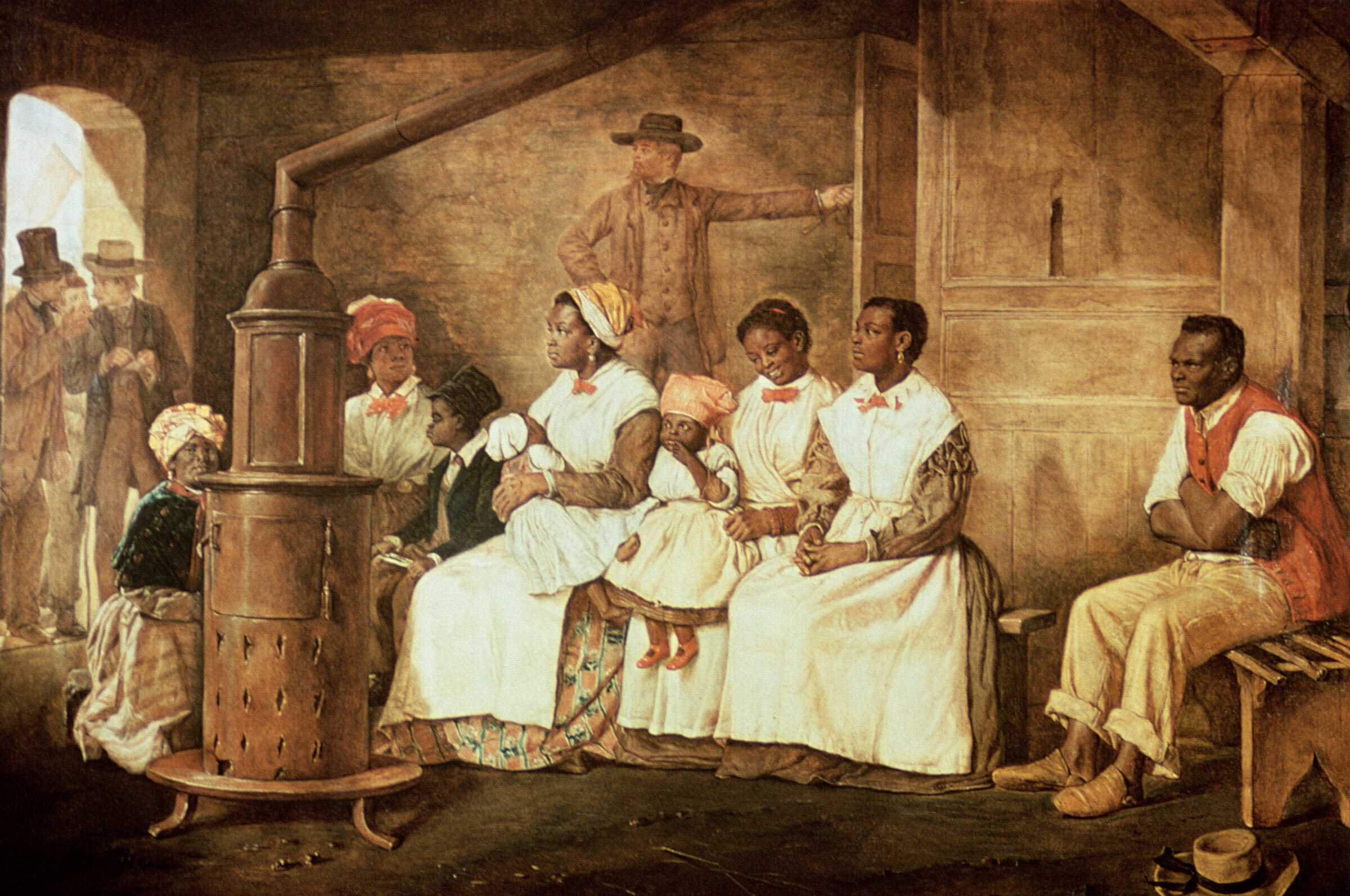Chapter 3
Domestic Slave Trade
Beginning in the late 18th century, the creation of the cotton gin, the expansion of the country, and the end of the nation’s involvement in the Transatlantic Slave Trade set the stage for an increased internal slave trade.
Between 1820 and 1860, as cotton cultivation expanded across the growing nation, roughly 1,000,000 enslaved people were torn away from their families and forced west and to the Deep South, placed on vast plantations along the Mississippi River Valley. Their labor created an empire of cotton that would transform the new nation into an economic world leader. Generations of enslaved Black people were traded on the auction block, bequeathed to relatives, sold to pay off debt, or given as gifts to young planters starting new lives. This immensely profitable trade in humans and forced migration had financial, political, and demographic repercussions still felt today.
The domestic slave trade caused immense suffering to African Americans, their families, and their communities. The desire for power and profit exacted a human cost.
Red Slave Market Flag
Red Slave Market Flag
This red flag was recovered from the Old Slave Mart in Charleston, South Carolina. Red flags outside slave sites signaled that enslaved people were "ready for sale" and often had an inventory of the enslaved attached. Sometimes enslaved children were sent through the streets carrying the red flag and ringing a bell to announce a slave sale.
Depictions of red auction flags can be seen in period images including several commissioned by journalist Eyre Crow, who documented slave auctions while traveling through the South. In the following 1861 painting entitled Slaves Waiting for Sale, a red flag is visible though the doorway. Flags can be seen in many period images of slave auctions.
Slaves Waiting for Sale, 1861
Mortgaged and Sold
Court-ordered Sale of Valuable People
Enslaved people were mortgaged and valued based on age, skills, and the ability to breed. This court-ordered sale of 99 people included five infants, Old Hester, Old Peter, and Old Nancy. The annotated document shows that the buyer valued Betty for breeding. The name Rose is crossed out—she is noted as dead.
Alexandria, Virginia: A Site of Slavery
John Armfield and Isaac Franklin were two of the nation’s most successful slave traders. This lantern slide shows the “Negro jail,” or slave pen, at their Virginia headquarters, located at 1315 Duke Street in Alexandria, just across the Potomac River from the nation’s capital. Enslaved people were held in the jail before being forced to the Deep South.
Solomon Northup, author of the narrative “12 Years a Slave,” recounted his experience in a nearby Washington, D.C., slave pen, noting, “The doom of the colored man, upon whom the door leading out of that narrow passage closed, was sealed.” Franklin and Armfield’s pen was also within walking distance from Alfred Street Baptist Church, founded by free African Americans in 1803. Today, the former trade site hosts the Freedom House Museum, which explores the history of slavery in Virginia.
View of a slave pen, Alexandria, Virginia
Map of the Alexandria, Virginia, Slave Port
An Inhospitable Trade
Broadside Advertising "Valuable Slaves at Auction"
Wealthy planters and dealers bartered in enslaved African Americans at slave auctions that took place in hotels, saloons, and public spaces throughout the South. This broadside advertises "SLAVES AT AUCTION" in the City Hotel in New Orleans. Isam, a "superior engineer and blacksmith," Pauline who speaks French and English, and other men, women, and children provided two sources of profit—their labor and their price on the auction block.
Slave Sale at the St. Louis Hotel
Sale of Estates, New Orleans
Enslaved African Americans were sold in many settings, including establishments like the St. Louis Hotel in New Orleans, as seen in this illustration.
A Fleshmonger’s Calling Card
Business Card for the “Great Negro Mart”
Byrd Hill owned and operated a large slave yard. His calling card announced the “Great Negro Mart” where a “general assortment of negroes” was available for purchase. The domestic slave trade made enormous profits for slave dealers, slave patrols, auctioneers, local law officials, and others who contributed to the business of trafficking in humans.
People, Farm Equipment, and Acreage for Sale
Bill of Sale for Equipment and Enslaved People
Enslaved people were bought and sold alongside livestock, farm equipment, and land. Slave traders and owners viewed the men, women, and children listed in this receipt as inventory. Dick, Queen, George, Wash, Henry, and Jim were sold along with a cattle yoke and over 400 acres of land.
Tagging Human Property: Thomas Porter Buttons
ID Button Used by Slave Trader Thomas Porter
Thomas Porter was a successful businessman and slave dealer. He was meticulous in his business dealings—the enslaved men and women that he held in captivity were forced to wear buttons bearing his name. By identifying his property, Porter placed his wealth and status on display, which was a draw for business.
The Fancy Girl Trade
Bill of Sale for Clary, 1806
Bill of Sale for Polly, 1835
Black women were the sexual prey of white men since the 1600s. During the domestic slave trade, a new category of enslaved women emerged, known as "fancy girls." Young and usually light-skinned, these Black women were purchased explicitly for sexual exploitation, at rates four to five times the price of women field laborers. Young Black men were also subject to sexual exploitation by both white men and women.

. . . grant bargain and sell . . . one Negro girl named Polly aged about sixteen years, yellow complexion and black Eyes . . . [to] have & to hold . . . unto . . . [the aforesaid] H Mood his heirs and assigns for ever.
Transcription from Bill of Sale for Polly, 1835
Witness to Inhumanity
Letter from David Selden to His Parents
At least 40 percent of enslaved African people forced to the United States arrived in Charleston, South Carolina. The port city proved lucrative for those involved in the slave trade, including Christopher Gadsden. Enslaved workers built his wharf, which would receive and house human cargo as they awaited sale. Eyewitness David Selden saw the public display of inhumanity and described it in this letter to his parents.

When I behold the frantic and delightfull appearance of the country from nature I cannot but reflect on the awfull sight to be seen at a place called Gadsdens Wharf of about four thousand poor africans naked in a maner and lous'y The most distressing sight I ever beheld offered for sale every day at Auction to him who will give the most.
David Selden, 1808
